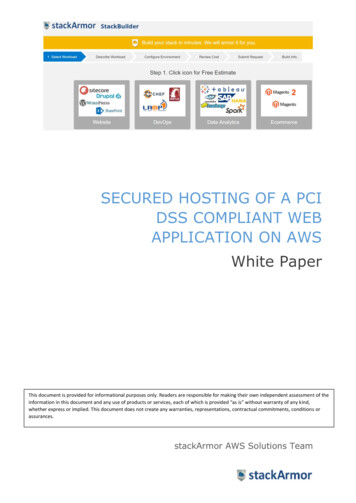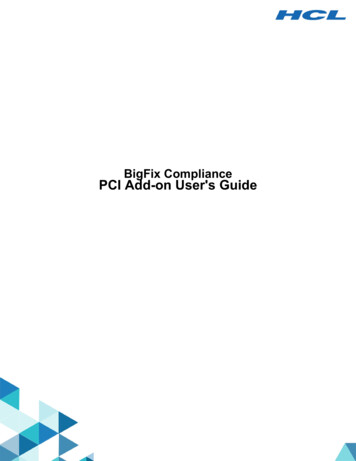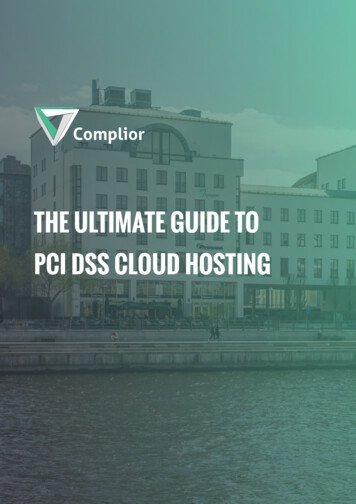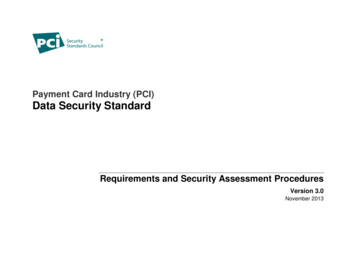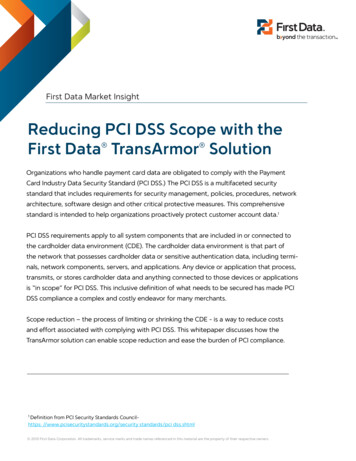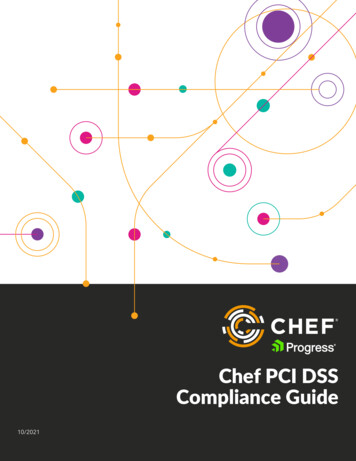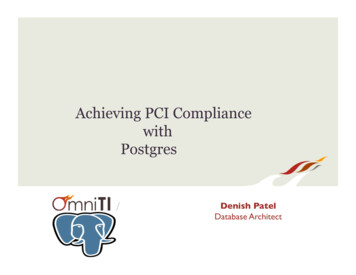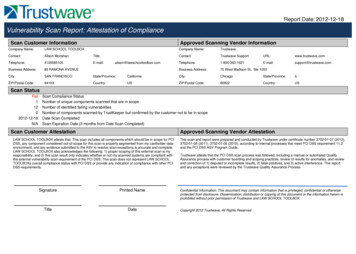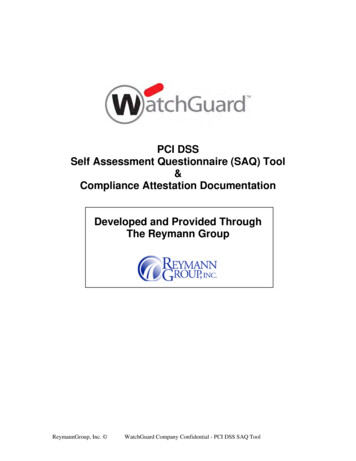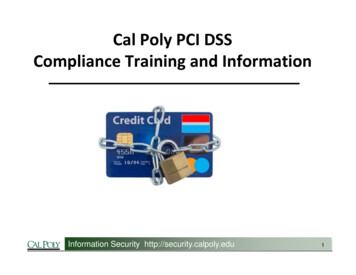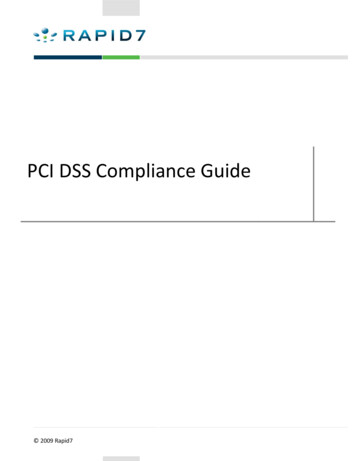
Transcription
PCI DSS Compliance Guide 2009 Rapid7
PCI DSS Compliance GuideWhat is the PCI DSS?Negative media coverage, a loss of customer confidence, and the resulting loss in sales can cripple a business.As a result, all entities that handle credit cardholder information are being challenged to adopt more effectivedata protection measures.The Payment Card Industry (PCI) Data Security Standard (DSS) was created toconfront the rising threat to credit cardholder personal information. The PCIDSS consists of the PCI Compliance Principles and Requirements for securingcredit cardholder data in both hardcopy and electronic formats. The PCI DSShas been adopted by companies in the credit card industry as the globalstandard for the protection of customer information. The PCI SecurityStandards Council (SSC) owns, develops, maintains and distributes the PCIDSS. The SSC also provides oversight for the Approved Scanning Vendor program that certifies companies asApproved Scanning Vendors (ASV). The PCI DSS encompasses twelve requirements for security management,policies, procedures, network architecture, software design, and other critical protective measures.The goal of PCI DSS is simple; protect cardholder account data. In the pursuit of this goal, the PCI SSC hasgained endorsement of the PCI-DSS by the five major payment card brands: Visa’s Cardholder InformationSecurity Program (CISP), MasterCard, Discover Financial Services, American Express, and JCB International.Who needs to be PCI compliant?The PCI SSC works with the five major payment card brands to ensure that merchants and service providersare PCI compliant. As a global standard, the PCI DSS applies to any entity worldwide that stores, processes ortransmits credit cardholder data. This includes financial institutions, merchants and service providers in allpayment channels. Financial institutions include banks, insurance companies, lending agencies, andbrokerages. Merchants include restaurants, retailers (brick-and-mortar, mail/telephone order, e-commerce),transportation operators, and virtually any point-of-sale that processes credit cards across all industries.Examples of service providers include transaction processors, payment gateways, customer service entities,(i.e. call centers), managed service providers, web hosting providers, data centers, and Independent SalesOrganizations.The five major payment card brands enforce PCI compliance validation by requiringmerchant banks to meet specific auditing and reporting criteria for their respectivemerchants and service providers. Each payment card brand has its own complianceprogram to uphold the PCI standard by enforcing PCI auditing and reportingrequirements that must be met by the acquiring banks for merchants (also calledmerchant banks) in order to provide access to their payment network. The merchantbank then needs to produce evidence that merchants using their bank, along with anyservice providers used by those merchants, are in fact PCI compliant. This chain of 2009 Rapid72
liability at each level is designed to protect credit cardholder data by using PCI-DSS to mitigate the risk of databreaches in the rapidly evolving threat landscape.MerchantsMerchants are subject to the following validation requirements from each payment card brand:VisaLevelCriteria1 AnnualReport onCompliance (ROC)Audit by QualifiedSecurity Assessor(QSA)Any merchant, regardless of acceptancechannel, processing more than 6 milliontransactions per yearAny merchant that suffered a securitybreach, resulting in an account compromiseAny merchant that Visa otherwise deems aLevel 12 Any merchant processing between 1 to 6million transactions per year3 Any merchant processing between 20,000 to1 million transactions per year4 Any merchant processing less than 20,000transactions per year (i.e. all othermerchants not in Levels 1, 2, or 3, regardlessof acceptance terlyInternal & ExternalVulnerability Scan &Penetration Test byApproved ScanningVendor (ASV) Recommended,not requiredRecommended,not requiredSource: http://usa.visa.com/merchants/risk management/cisp merchants.html Rapid7 helps meet Report on Compliance (ROC) Audits through our trusted partner Qualified Security Assessors (QSAs). 2009 Rapid73
MastercardLevelCriteria1 2 AnnualReport onCompliance (ROC)Audit by QualifiedSecurity Assessor(QSA)Any merchant, regardless of acceptancechannel, processing greater than 6 milliontransactions per yearAny merchant that suffered a securitybreach, resulting in an account compromiseAny merchant that Mastercard otherwisedeems a Level 1Any merchant processing greater than 1million, but less than or equal to 6 milliontransactions per year3 Any merchant processing greater than20,000, but less than or equal to 1 milliontransactions per year4 All other merchants (i.e. any merchantprocessing 20,000 or less Q)QuarterlyInternal & ExternalVulnerability Scan &Penetration Test byApproved ScanningVendor (ASV) **At merchantdiscretionRecommended,not requiredRecommended,not requiredSource: t levels.html *Rapid7 helps meet Report on Compliance (ROC) Audits through our trusted partner Qualified Security Assessors (QSAs).MasterCard announced revised requirements for Level 2 merchants. Effective 30 June 2011, Level 2 merchants thatchoose to complete an annual self-assessment questionnaire must ensure that staff engaged in the self-assessment attendPCI SSC-offered merchant training programs and pass any associated PCI SSC accreditation program annually in order tocontinue the option of self-assessment for compliance validation. Alternatively, Level 2 merchants may, at their owndiscretion, complete an annual onsite assessment conducted by a PCI SSC approved QSA rather than complete an annualself-assessment questionnaire. 2009 Rapid74
AMEXLevelCriteria1 AnnualReport onCompliance (ROC)Audit by QualifiedSecurity Assessor(QSA)Any merchant, regardless of acceptancechannel, processing more than 2.5 milliontransactions per yearAny merchant that has had a data incidentAny merchant that American Expressotherwise deems a Level 12 Any merchant processing between 50,000 to2.5 million American Express Cardtransactions per year3 Any merchant processing less than 50,000American Express Card transactions erlyInternal & ExternalVulnerability Scan &Penetration Test byApproved ScanningVendor (ASV) Recommended,not requiredRecommended,not requiredSource: voice/pdfs/en US/DSOP Merchant US.pdf Rapid7 helps meet Report on Compliance (ROC) Audits through our trusted partner Qualified Security Assessors (QSAs). 2009 Rapid75
DiscoverLevelCriteria1234AnnualReport onCompliance (ROC)Audit by QualifiedSecurity Assessor(QSA) All merchants processing a total of morethan 6 million card transactions annually onthe Discover network. Any merchant Discover, in its sole discretion,determines should meet the Level 1compliance validation and reportingrequirements All merchants required by another paymentbrand to validate and report theircompliance as a Level 1 merchant All merchants processing a total of 1 millionto 6 million card transactions annually onthe Discover network. All merchants required by another paymentbrand to validate and report theircompliance as a Level 2 merchant All merchants processing a total of 20,000 to1 million card-not-present only transactionsannually on the Discover network All merchants required by another paymentbrand to validate and report theircompliance as a Level 3 merchant All other rterlyInternal & ExternalVulnerability Scan &Penetration Test byApproved ScanningVendor (ASV) Recommended,not requiredRecommended,not requiredSource: html Rapid7 helps meet Report on Compliance (ROC) Audits through our trusted partner Qualified Security Assessors (QSAs).Discover authorizes use of either an annual on-site review by QSA or the merchant’s internal auditor. 2009 Rapid76
JCB InternationalLevelCriteriaMerchants whohandle cardholderdata and transactiondata via the Internetor Internetaccessible network AnnualReport onCompliance(ROC) Audit byQualified SecurityAssessor (QSA)All merchants processing atotal of 1 million JCBtransactions or more peryearAnnualSelfAssessmentQuestionnaire(SAQ) Recommended,not requiredRecommended,not requiredAll merchants processing lessthan 1 million JCBtransactions per yearRecommended,not requiredMerchants who donot handlecardholder data andtransaction data viathe Internet norInternet-accessiblenetwork QuarterlyInternal & ExternalVulnerability Scan &Penetration Test byApproved ScanningVendor (ASV)All merchants processing 1million JCB transactions ormore per yearRecommended,not required Recommended,not requiredAll other merchantsRecommended,not requiredSource: http://www.jcb-global.com/english/jdsp/index.html Rapid7 helps meet Report on Compliance (ROC) Audits through our trusted partner Qualified Security Assessors (QSAs). 2009 Rapid77
Service providersService providers are organizations that process, store, or transmit cardholder data on behalf of credit cardclients, merchants, or other service providers. The major payment brands have different “terms” for serviceproviders. Service providers are subject to the following validation requirements, as specified by each brand:VisaLevelCriteria1 2 AnnualReport onCompliance(ROC) Audit byQualified SecurityAssessor (QSA)VisaNet processors or any serviceprovider that stores, processes and/ortransmits over 300,000 transactionsper lyInternal & ExternalVulnerability Scan andPenetration Test byApproved ScanningVendor (ASV) Any service provider that stores,processes and/or transmits less than300,000 transactions per yearSource: http://usa.visa.com/merchants/risk management/cisp service providers.html Rapid7 helps meet Report on Compliance (ROC) Audits through our trusted partner Qualified Security Assessors (QSAs). 2009 Rapid78
MastercardLevelCriteria12AnnualReport onCompliance(ROC) Audit byQualified SecurityAssessor (QSA) All TPPsAll DSE’s that store, transmit, orprocess greater than 300,000 totalcombined MasterCard and Maestrotransactions annually Includes all DSE’s that store, transmit,or process less than 300,000 totalcombined MasterCard and Maestrotransactions rterlyInternal & ExternalVulnerability Scan andPenetration Test byApproved ScanningVendor (ASV) Source: serviceprovider levels.html Rapid7 helps meet Report on Compliance (ROC) Audits through our trusted partner Qualified Security Assessors (QSAs). 2009 Rapid79
AMEXLevelCriteria 1AnnualReport onCompliance(ROC) Audit byQualified SecurityAssessor (QSA)All lyInternal & ExternalVulnerability Scan andPenetration Test byApproved ScanningVendor (ASV) Source: voice/pdfs/en US/DSOP Service Provider US.pdf Rapid7 helps meet Report on Compliance (ROC) Audits through our trusted partner Qualified Security Assessors (QSAs).AMEX authorizes use of use either an annual on-site review by QSA or internal auditor of the Service Provider if certified(i.e. signed) by the chief executive officer, chief financial officer, or principal of the Service Provider.DiscoverLevelCriteria 1AnnualReport onCompliance(ROC) Audit byQualified SecurityAssessor rlyInternal & ExternalVulnerability Scan andPenetration Test byApproved ScanningVendor (ASV)All Service Providers Source: html Rapid7 helps meet Report on Compliance (ROC) Audits through our trusted partner Qualified Security Assessors (QSAs).Discover authorizes use of either an annual on-site review by QSA or an annual SAQ using PCI-DSS v1.2. 2009 Rapid710
JCB InternationalLevelCriteria1 2 AnnualReport onCompliance(ROC) Audit byQualified SecurityAssessor (QSA)All Payment Processors who handlecardholder data and transaction datavia the Internet or Internetaccessible networkAll Payment Processors who do nothandle cardholder data andtransaction data via the Internet norInternet-accessible terlyInternal & ExternalVulnerability Scan andPenetration Test byApproved ScanningVendor (ASV) Recommended,not requiredRecommended,not required Recommended,not requiredSource: http://www.jcb-global.com/english/jdsp/index.html Rapid7 helps meet Report on Compliance (ROC) Audits through our trusted partner Qualified Security Assessors (QSAs). 2009 Rapid711
How Rapid7 HelpsRapid7 has extensive experience partnering with financial institutions, merchants and service providersnationwide such as Stein Mart, Trader Joe’s, Olympia Sports, The Blackstone Group, LendingTree, and E*TRADEFINANCIAL, to help them with their security and compliance requirements. Rapid7’s PCI Compliance Solutionsmeet the data security standards required for merchants and service providers to achieve PCI compliance byaddressing PCI DSS v1.2 Requirement 6.5, 6.6, 11.2 and 11.3 as follows: Performing quarterly internal and external vulnerability scans - Rapid7 has been recertified as anApproved Scanning Vendor (ASV) by the PCI Security Standards Council, authorizing us to help youachieve compliance with the PCI Data Security Standard (DSS). Rapid7 PCI Compliance Servicesperform an independent, quarterly ASV vulnerability scans and produce the certified documentationfor your records. In addition, Rapid7 helps meet Report on Compliance (ROC) Audits through ourtrusted partner Qualified Security Assessors (QSAs). (Requirement 11.2) Leveraging Rapid7 Managed PCI Services to provide the added value of automated quarterly scansincluding external vulnerability scanning - Includes up to twelve rescans per quarter without at noextra charge, full remediation plans, eight hours of consulting time with one of our professionalsecurity consultants (2 hours per quarter) to review scan results and discuss remediationrecommendations as well as any requested scan & report configuration changes. (Requirement 11.2) Performing Rapid7 PCI Compliance Services - Offering annual internal and external penetrationtesting services required by PCI DSS in order to detect deficiencies more quickly and provide detailedrecommendations for fixes that would prevent attacks. (Requirement 11.3) Performing Rapid7 PCI Gap Analysis - For a detailed audit of your networked environment, Webapplication development secure coding policies, physical security control policies, training polices, andpersonnel policies, in addition to providing guidance on network segmentation to show you how toreduce the scope of your PCI audit and limit your cardholder segment. (Requirement 6.5) Performing Web application assessment testing - To identify vulnerabilities based on the OWASP Top10 vulnerability list, in addition to providing Security Awareness Training, OWASP web developmenttraining and CEH/Penetration test training on request. (Requirement 6.6) Providing assistance in completing the appropriate PCI Self-Assessment Questionnaire (SAQ) - Whenrequired for PCI certification. 2009 Rapid712
Rapid7 Solutions for the Payment Card Industry Data Security Standard (PCI DSS)To meet PCI compliance, merchants adhere to the twelve PCI DSS requirements outlined below.PCI RequirementsDetailed RequirementsRequirement 1Install and maintaina firewall configuration toprotect cardholder data1.1Establish firewall and routerconfiguration standards that include:network connectivity diagrams;documentation of formal testing offirewall and router rules, review andchange processes; documentation ofroles engaged in networkcomponent logical management;and business justification for use ofall services, protocols, and portsallowed1.2Build a firewall configuration thatrestricts connections betweenuntrusted networks and any systemcomponents in the cardholder dataenvironment.1.3Prohibit direct public accessbetween the Internet and anysystem component in the cardholderdata environment.Rapid7 SolutionUse Rapid7 NeXpose to: Provide customizable scan settings that can be usedto setup a baseline configuration of policies andsettings to use when performing on-going scanningof firewalls, routers, switches, hubs, ports andnetwork services. Generate a comprehensivemapping of network devices and services in order todetect devices and services that may allowconnections between an untrusted network and anysystem components in the cardholder environment.(Requirement 1.1) Scan and monitor firewall configuration and routerfor vulnerabilities, and adherence to baselineconfiguration and policy settings, specifically todetect configuration violations that allowunauthorized connections between cardholder dataenvironments and untrusted networks.(Requirement 1.2)Use Rapid7 PCI Consulting Services to: Requirement 2Do not use vendor-supplieddefaults for systems1.4Install personal firewall software onany mobile and/or employee-ownedcomputers with direct connectivityto the Internet (for example, laptopsused by employees), which are usedto access the organization’s network.2.1Always change vendor-supplieddefaults before installing a systemon the network—for example,include passwords, simple networkmanagement protocol (SNMP)community strings, and eliminationof unnecessary accounts.2.2 2009 Rapid7Develop configuration standards forall system components. Assure thatthese standards address all knownsecurity vulnerabilities and areRecommend best practices to optimize networksecurity components, including firewall and routerconfiguration standards Evaluate and documentsecurity controls, identify gaps in your securityprogram, determine if security policies are beingfollowed in actual day-to-day operations, andrecommend ways to address any deficiencies.(Requirement 1.3 and 1.4)Use Rapid7 NeXpose to: Utilize our customized policy compliance frameworkto monitor for access violations, including number oflogin attempts, password length, allowable specialcharacters etc. Audits users and groups on yoursystems, and discovers unnecessary accounts to beeliminated (i.e. default vendor-supplied accounts,terminated employee accounts), allowing you toreview results either in the UI or in a report formatso you can then use the data to inform yourinformation access and management policies.13
PCI RequirementsDetailed RequirementsRapid7 Solutionconsistent with industry-acceptedsystem hardening standards.(Requirement 2.1) 2.32.4Requirement 3Protect stored cardholderdata3.1Shared hosting providers mustprotect each entity’s hostedenvironment and cardholder data.These providers must meet specificrequirements as detailed inAppendix A: Additional PCI DSSRequirements for Shared HostingProviders.Keep cardholder data storage to aminimum. Develop a data retentionand disposal policy. Limit storageamount and retention time to thatwhich is required for business, legal,and/or regulatory purposes, asdocumented in the data retentionpolicy.3.2Do not store sensitive authenticationdata after authorization (even ifencrypted).3.3Mask PAN when displayed (the firstsix and last four digits are themaximum number of digits to bedisplayed).3.4 2009 Rapid7Encrypt all non-consoleadministrative access. Usetechnologies such as SSH, VPN, orSSL/TLS for web-based managementand other non-consoleadministrative access.Render PAN, at minimum,unreadable anywhere it is stored(including on portable digital media,backup media, in logs) by using anyof the following approaches: Oneway hashes based on strongcryptography; Truncation; IndexUtilize our customized policy compliance frameworkto configure and implement automated monitoringaccess controls based on your own internal policiesor based on best practices defined by externalgroups (i.e. SANS, CIS or NIST). (Requirement 2.2)Use Rapid7 PCI Consulting Services to: Evaluate configuration of all non-consoleadministrative access to ensure appropriate use ofencryption in security controls, and to identifyvulnerabilities that could lead to tampering withencryption keys in files and other encryptioncontrols. (Requirement 2.3) Evaluate and recommend if shared hosting providersmeet requirements defined in Appendix A:Additional PCI DSS Requirements for Shared HostingProviders. (Requirement 2.4)Use Rapid7 PCI Consulting Services to: Evaluate cardholder data policy to ensureappropriate data retention and disposal policiesdocumentation as part of Rapid7 PCI Gap Analysis.Test if documentation is followed in practice byadding Rapid7 Social Engineering services to yourGap Analysis. (Requirement 3.1) Identifies gaps in your security program, determinesif security policies are being followed in actual dayto-day operations (i.e. data storage policies, PANmasking, and protection of cryptographic keys aspart of PCI Gap Analysis and Penetration Testing.(Requirements 3.2 to 3.5) Evaluate key-management processes andprocedures for encryption of cardholder data, andprovide recommendations as part of Rapid7 PCI GapAnalysis. (Requirement 3.6)14
PCI RequirementsDetailed RequirementsRapid7 Solutiontokens and pads (pads must besecurely stored); Strongcryptography with associated keymanagement processes andproceduresRequirement 4Encrypt transmission ofcardholder data across open,public networks3.5Protect cryptographic keys used forencryption of cardholder dataagainst both disclosure and misuse.3.6Fully document and implement allkey-management processes andprocedures for cryptographic keysused for encryption of cardholderdata.Use strong cryptography andsecurity protocols such as SSL/TLS orIPSEC to safeguard sensitivecardholder data during transmissionover open, public networks.4.14.2Use Rapid7 NeXpose to: Never send unencrypted PANs byend-user messaging technologies (forexample, e-mail, instant messaging,chat).Utilize our customized policy compliance frameworkto configure and monitor traffic over secured andunsecured ports. Identify all open ports, and logs allinformation, including any evidence that any Webapplications, software enterprise applications, ordatabases are not using the ports assigned as secureports for transmitting secure cardholder data.(Requirement 4.1)Use Rapid7 PCI Consulting Services to: Requirement 5Use and regularly updateantivirus software5.15.2 2009 Rapid7Deploy anti-virus software on allsystems commonly affected bymalicious software (particularlypersonal computers and servers).Ensure that all anti-virus mechanismsare current, actively running, andcapable of generating auditRecommend best practices to optimize data security,including end-user messaging policies. Evaluate anddocument security controls, identify gaps in yoursecurity program, determine if security policies arebeing followed in actual day-to-day operations, andrecommend ways to address any deficiencies.(Requirement 4.2)Use Rapid7 NeXpose to: Provide customizable scan settings forcontinuous, automatically generated,comprehensive mapping of all assets, includingapplications such as anti-virus software.(Requirement 5.1) Utilize our customizable risk scoring, policyauditing, and vulnerability scanning to alert you ofpolicy violations or misconfigurations, includingversioning and patch levels. (Requirement 5.2)15
PCI RequirementsDetailed RequirementsRapid7 SolutionRequirement 6Develop and maintain securesystems and applications6.1Use Rapid7 NeXpose to:6.2Ensure that all system componentsand software have the latest vendorsupplied security patches installed.Install critical security patches withinone month of release.Establish a process to identify newlydiscovered security vulnerabilities(for example, subscribe to alertservices freely available on theInternet). Update configurationstandards as required by PCI DSSRequirement 2.2 to address newvulnerability issues.6.3Develop software applications inaccordance with PCI DSS (forexample, secure authentication andlogging) and based on industry bestpractices, and incorporateinformation security throughout thesoftware development life cycle6.4Follow change control procedures forall changes to system components.6.5Develop all web applications (internaland external, and including webadministrative access to application)based on secure coding guidelinessuch as the Open Web ApplicationSecurity Project Guide.6.6 Scan all system assets to ensure security patches andconfigurations are maintained based on userspecified parameters for all system components andsoftware, including Web applications, enterprisesoftware, network components, and databases.(Requirement 6.1) Perform both scheduled and ad-hoc internalvulnerability scans to monitor the security posturebased on vulnerabilities, configuration, andcompliance status of your entire infrastructure,including network devices, databases, Webapplications, off-the-shelf commercial/enterpriseapplications, open source applications, in-housecustom applications, servers, operating systems,services and all IP-enabled devices using the mostup-to-date vulnerability checks provided by Rapid7’supdate services. NeXpose checks for updates every6 hours; there is a 24-hour SLA for Windowsmachines when new Microsoft vulnerability bulletinsare released. Provides up-to-date vulnerabilitychecks, including reliable 24 hour response toMicrosoft Patch Tuesday, plus new vulnerabilitiesupdates twice per month. (Requirement 6.2 and6.6) Perform ad-hoc vulnerability scans to monitor thesecurity posture based on vulnerabilities,comparison to desired baseline configuration, andcompliance status of specific systems, including anycustom Web applications or custom installedapplications. NeXpose allows administrators tosetup custom asset groups. Applications underdevelopment can be put in an asset group in atesting area outside the production environment,and scanned for vulnerabilities to validate thatsecure coding guidelines are incorporated into thechange control procedures. Fix weak codethroughout the entire software development cycle,and continue on an on-going basis to address newthreats. (Requirement 6.3 to 6.4, and 6.6)For public-facing web applications,address new threats andvulnerabilities on an ongoing basisand ensure these applications areprotected against known attacksUse Rapid7 PCI Consulting Services to: 2009 Rapid7Review custom Web application coding to ensuresecure best practices based on secure coding16
PCI RequirementsDetailed RequirementsRapid7 Solutionguidelines by testing the application using the FullOWASP Testing Methodology framework from theOpen Web Application Security Project Guide aspart of an onsite PCI Gap Analysis. Complete Webapplication assessment testing to identifyvulnerabilities based on the OWASP Top 10.(Requirement 6.5)Requirement 7Restrict access to cardholderdata by business need-toknow7.17.2Limit access to system componentsand cardholder data to only thoseindividuals whose job requires suchaccess.Use Rapid7 PCI Consulting Services to: Establish an access control system forsystems components with multipleusers that restricts access based on auser’s need to know, and is set to“deny all” unless specifically allowed.Recommend best practices to optimize data security,including system access policies to limit access tosystem components and cardholder data to onlythose whose job role absolutely requires suchaccess. Evaluate and document security controls,identify gaps in your security program, determine ifsecurity policies are being followed in actual day-today operations, and recommend ways to addressany deficiencies. (Requirement 7.1)Use Rapid7 NeXpose to: Requirement 8Assign a unique ID to eachperson with computer access8.18.28.3 2009 Rapid7Assign all users a unique ID beforeallowing them to access systemcomponents or cardholder data.In addition to assigning a unique ID,employ at least one of the followingmethods to authenticate all users:Password or passphrase; Two-factorauthentication (for example, tokendevices, smart cards, biometrics, orpublic keys)Incorporate two-factor authenticationfor remote access (network-levelaccess originating from outside thenetwork) to the network byemployees, administrators, and thirdparties. Use technologies such asremote authentication and dial-inLeverage our customized policy complianceframework to set up automated monitoring accesscontrols (including adherence to policies for rolebased access) to validate enforcement of accessrestrictions. (Requirement 7.2)Use Rapid7 NeXpose to: Leverage our customized policy complianceframework to set up automated monitoring accesscontrols, including number of login attempts,password length, allowable special characters, andother login ID access control policies. (Requirement8.1 - 8.2, 8.4)Use Rapid7 PCI Consulting Services to: Recommend best practices to optimize data security,including usage of two-factor authentication forremote access to the network, secure dial-in service,terminal access controls with tokens, or VPNs withindividual certificates. (Requirement 8.3)Evaluate and document security controls, identifygaps in your security program, determine if securitypolicies are being followed in actual day-to-day17
PCI RequirementsDetailed RequirementsRapid7 Solutionservice (RADIUS); terminal accesscontroller access control system(TACACS) with tokens; or VPN (basedon SSL/TLS or IPSEC) with individualcertificates.Requirement 9Restrict physical access tocardholder data8.4Render all passwords unreadableduring transmission and storage on allsystem components using strongcryptography (defined in PCI DSSGlossary of Terms, Abbreviations, andAcronyms).8.5Ensure proper user authenticationand password management for n
The five major payment card brands enforce PCI compliance validation by requiring merchant banks to meet specific auditing and reporting criteria for their respective merchants and service providers. Each payment card brand has its own compliance program to uphold the PCI standard by enforcing PCI auditing and reporting
